Multiple Host Factors Interact with the Hypervariable Domain of Chikungunya Virus nsP3 and Determine Viral Replication in Cell-Specific Mode
- PMID: 29899097
- PMCID: PMC6069204
- DOI: 10.1128/JVI.00838-18
Multiple Host Factors Interact with the Hypervariable Domain of Chikungunya Virus nsP3 and Determine Viral Replication in Cell-Specific Mode
Abstract
Alphaviruses are widely distributed in both hemispheres and circulate between mosquitoes and amplifying vertebrate hosts. Geographically separated alphaviruses have adapted to replication in particular organisms. The accumulating data suggest that this adaptation is determined not only by changes in their glycoproteins but also by the amino acid sequence of the hypervariable domain (HVD) of the alphavirus nsP3 protein. We performed a detailed investigation of chikungunya virus (CHIKV) nsP3 HVD interactions with host factors and their roles in viral replication in vertebrate and mosquito cells. The results demonstrate that CHIKV HVD is intrinsically disordered and binds several distinctive cellular proteins. These host factors include two members of the G3BP family and their mosquito homolog Rin, two members of the NAP1 family, and several SH3 domain-containing proteins. Interaction with G3BP proteins or Rin is an absolute requirement for CHIKV replication, although it is insufficient to solely drive it in either vertebrate or mosquito cells. To achieve a detectable level of virus replication, HVD needs to bind members of at least one more protein family in addition to G3BPs. Interaction with NAP1L1 and NAP1L4 plays a more proviral role in vertebrate cells, while binding of SH3 domain-containing proteins to a proline-rich fragment of HVD is more critical for virus replication in the cells of mosquito origin. Modifications of binding sites in CHIKV HVD allow manipulation of the cell specificity of CHIKV replication. Similar changes may be introduced into HVDs of other alphaviruses to alter their replication in particular cells or tissues.IMPORTANCE Alphaviruses utilize a broad spectrum of cellular factors for efficient formation and function of replication complexes (RCs). Our data demonstrate for the first time that the hypervariable domain (HVD) of chikungunya virus nonstructural protein 3 (nsP3) is intrinsically disordered. It binds at least 3 families of cellular proteins, which play an indispensable role in viral RNA replication. The proteins of each family demonstrate functional redundancy. We provide a detailed map of the binding sites on CHIKV nsP3 HVD and show that mutations in these sites or the replacement of CHIKV HVD by heterologous HVD change cell specificity of viral replication. Such manipulations with alphavirus HVDs open an opportunity for development of new irreversibly attenuated vaccine candidates. To date, the disordered protein fragments have been identified in the nonstructural proteins of many other viruses. They may also interact with a variety of cellular factors that determine critical aspects of virus-host interactions.
Keywords: BIN1; CD2AP; Eilat virus; G3BP1; G3BP2; NAP1L1; alphavirus; chikungunya virus; viral RNA replication; virus-host interactions.
Copyright © 2018 American Society for Microbiology.
Figures
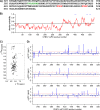

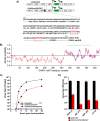
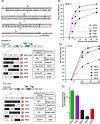

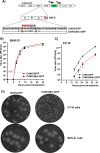
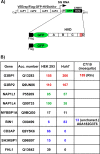

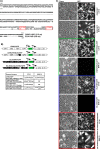
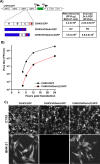

Similar articles
-
NAP1L1 and NAP1L4 Binding to Hypervariable Domain of Chikungunya Virus nsP3 Protein Is Bivalent and Requires Phosphorylation.J Virol. 2021 Jul 26;95(16):e0083621. doi: 10.1128/JVI.00836-21. Epub 2021 Jul 26. J Virol. 2021. PMID: 34076483 Free PMC article.
-
Structural and Functional Characterization of Host FHL1 Protein Interaction with Hypervariable Domain of Chikungunya Virus nsP3 Protein.J Virol. 2020 Dec 9;95(1):e01672-20. doi: 10.1128/JVI.01672-20. Print 2020 Dec 9. J Virol. 2020. PMID: 33055253 Free PMC article.
-
G3BP/Rin-Binding Motifs Inserted into Flexible Regions of nsP2 Support RNA Replication of Chikungunya Virus.J Virol. 2022 Nov 9;96(21):e0127822. doi: 10.1128/jvi.01278-22. Epub 2022 Oct 13. J Virol. 2022. PMID: 36226983 Free PMC article.
-
The Putative Roles and Functions of Indel, Repetition and Duplication Events in Alphavirus Non-Structural Protein 3 Hypervariable Domain (nsP3 HVD) in Evolution, Viability and Re-Emergence.Viruses. 2021 May 28;13(6):1021. doi: 10.3390/v13061021. Viruses. 2021. PMID: 34071712 Free PMC article. Review.
-
Molecular Virology of Chikungunya Virus.Curr Top Microbiol Immunol. 2022;435:1-31. doi: 10.1007/82_2018_146. Curr Top Microbiol Immunol. 2022. PMID: 30599050 Review.
Cited by
-
A Tale of 20 Alphaviruses; Inter-species Diversity and Conserved Interactions Between Viral Non-structural Protein 3 and Stress Granule Proteins.Front Cell Dev Biol. 2021 Feb 11;9:625711. doi: 10.3389/fcell.2021.625711. eCollection 2021. Front Cell Dev Biol. 2021. PMID: 33644063 Free PMC article.
-
Identification of mosquito proteins that differentially interact with alphavirus nonstructural protein 3, a determinant of vector specificity.PLoS Negl Trop Dis. 2023 Jan 25;17(1):e0011028. doi: 10.1371/journal.pntd.0011028. eCollection 2023 Jan. PLoS Negl Trop Dis. 2023. PMID: 36696390 Free PMC article.
-
Cryo-EM reveals a double oligomeric ring scaffold of the CHIKV nsP3 peptide in complex with the NTF2L domain of host G3BP1.mBio. 2025 May 14;16(5):e0396724. doi: 10.1128/mbio.03967-24. Epub 2025 Apr 11. mBio. 2025. PMID: 40214262 Free PMC article.
-
Lack of nsP2-specific nuclear functions attenuates chikungunya virus replication both in vitro and in vivo.Virology. 2019 Aug;534:14-24. doi: 10.1016/j.virol.2019.05.016. Epub 2019 May 28. Virology. 2019. PMID: 31163352 Free PMC article.
-
nsP4 Is a Major Determinant of Alphavirus Replicase Activity and Template Selectivity.J Virol. 2021 Sep 27;95(20):e0035521. doi: 10.1128/JVI.00355-21. Epub 2021 Jul 28. J Virol. 2021. PMID: 34319783 Free PMC article.
References
-
- Griffin DE. 2001. Alphaviruses, p 917–962. In Knipe DM, Howley PM, Griffin DE, Lamb RA, Martin MA, Roizman B, Straus SE (ed), Fields virology, 4th ed Lippincott Williams & Wilkins, Philadelphia, PA.
-
- Weaver SC, Frolov I. 2005. Togaviruses, p 1010–1024. In Mahy BWJ, ter Meulen V (ed), Virology, vol 2 Hodder Arnold, Salisbury, United Kingdom.
Publication types
MeSH terms
Substances
Grants and funding
LinkOut - more resources
Full Text Sources
Other Literature Sources
Medical
Miscellaneous

